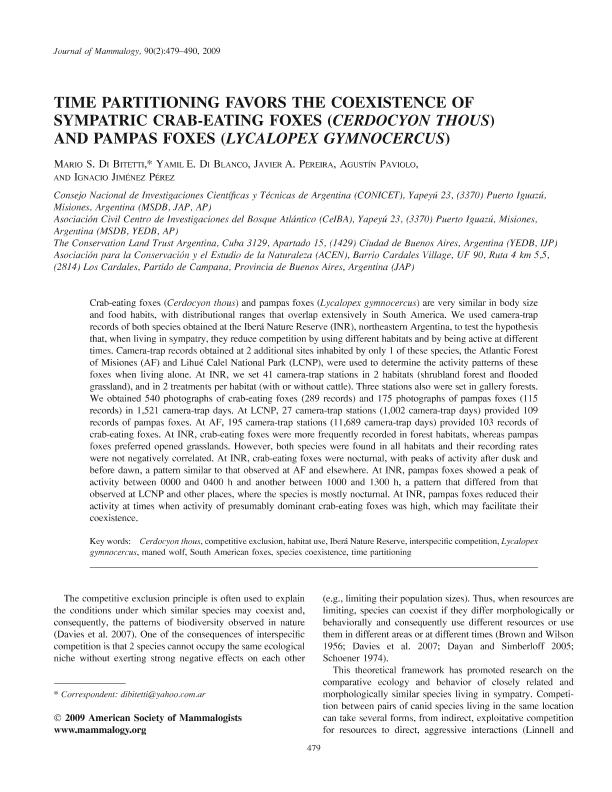Artículo
Time partitioning favors the coexistence of sympatric crab-eating fox (cerdocyon thous) and pampas foxes (lycalopex gymnocercus)
Di Bitetti, Mario Santiago ; Di Blanco, Yamil Edgardo
; Di Blanco, Yamil Edgardo ; Pereira, Javier Adolfo
; Pereira, Javier Adolfo ; Paviolo, Agustin Javier
; Paviolo, Agustin Javier ; Jiménez Pírez, Ignacio
; Jiménez Pírez, Ignacio
 ; Di Blanco, Yamil Edgardo
; Di Blanco, Yamil Edgardo ; Pereira, Javier Adolfo
; Pereira, Javier Adolfo ; Paviolo, Agustin Javier
; Paviolo, Agustin Javier ; Jiménez Pírez, Ignacio
; Jiménez Pírez, Ignacio
Fecha de publicación:
04/2009
Editorial:
Alliance Communications Group Division Allen Press
Revista:
Journal of Mammalogy
ISSN:
0022-2372
e-ISSN:
1545-1542
Idioma:
Inglés
Tipo de recurso:
Artículo publicado
Clasificación temática:
Resumen
Crab-eating foxes (Cerdocyon thous) and pampas foxes (Lycalopex gymnocercus) are very similar in body size and food habits, with distributional ranges that overlap extensively in South America. We used camera-trap records of both species obtained at the Ibera´ Nature Reserve (INR), northeastern Argentina, to test the hypothesis that, when living in sympatry, they reduce competition by using different habitats and by being active at different times. Camera-trap records obtained at 2 additional sites inhabited by only 1 of these species, the Atlantic Forest of Misiones (AF) and Lihue´ Calel National Park (LCNP), were used to determine the activity patterns of these foxes when living alone. At INR, we set 41 camera-trap stations in 2 habitats (shrubland forest and flooded grassland), and in 2 treatments per habitat (with or without cattle). Three stations also were set in gallery forests. We obtained 540 photographs of crab-eating foxes (289 records) and 175 photographs of pampas foxes (115 records) in 1,521 camera-trap days. At LCNP, 27 camera-trap stations (1,002 camera-trap days) provided 109 records of pampas foxes. At AF, 195 camera-trap stations (11,689 camera-trap days) provided 103 records of crab-eating foxes. At INR, crab-eating foxes were more frequently recorded in forest habitats, whereas pampas foxes preferred opened grasslands. However, both species were found in all habitats and their recording rates were not negatively correlated. At INR, crab-eating foxes were nocturnal, with peaks of activity after dusk and before dawn, a pattern similar to that observed at AF and elsewhere. At INR, pampas foxes showed a peak of activity between 0000 and 0400 h and another between 1000 and 1300 h, a pattern that differed from that observed at LCNP and other places, where the species is mostly nocturnal. At INR, pampas foxes reduced their activity at times when activity of presumably dominant crab-eating foxes was high, which may facilitate their coexistence.
Archivos asociados
Licencia
Identificadores
Colecciones
Articulos(CCT - NORDESTE)
Articulos de CTRO.CIENTIFICO TECNOL.CONICET - NORDESTE
Articulos de CTRO.CIENTIFICO TECNOL.CONICET - NORDESTE
Articulos(MACNBR)
Articulos de MUSEO ARG.DE CS.NAT "BERNARDINO RIVADAVIA"
Articulos de MUSEO ARG.DE CS.NAT "BERNARDINO RIVADAVIA"
Citación
Di Bitetti, Mario Santiago; Di Blanco, Yamil Edgardo; Pereira, Javier Adolfo; Paviolo, Agustin Javier; Jiménez Pírez, Ignacio; Time partitioning favors the coexistence of sympatric crab-eating fox (cerdocyon thous) and pampas foxes (lycalopex gymnocercus); Alliance Communications Group Division Allen Press; Journal of Mammalogy; 90; 2; 4-2009; 479-490
Compartir
Altmétricas



